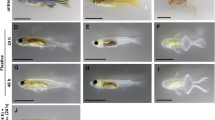Summary
Sulfur containing neuropeptides could be demonstrated in semithin sections of invertebrate nervous tissue, especially of gastropods, by using the bromobimanes as fluorescent labeling agents for thiol groups. Semithin sections showed a brilliant fluorescence of labeled peptides and should be used if an excellent resolution is important. The three bromobimanes (MB: monobromobimane, DB: dibromobimane, MQ: monobromotrimethylammoniobimane) gave positive results under our experimental conditions. Dibromobimane (DB) was selected because the application is more convenient.
In gastropods, the bromobimane technique seems to be the most specific and sensitive one compared to the classical neurosecretory staining methods. Neuropeptides with sulfur containing amino acids could be demonstrated in perikarya, axons, and axon swellings easily. We suppose that there are neurons—not stainable by the classical methods—which can be identified as peptidergic ones by the bromobimane technique.
A slight reduction of fluorescence intensity (fading) was observed. So, the fading rate was determined for dibromobimane reaction products; a decrease in the fluorescence intensity of 50% was only reached after 1 h using a Neofluar objective 10/0.30. Nevertheless, we suppose that a comparative quantification of the labeled neuropeptides should be possible if special parameters are considered.
Similar content being viewed by others
References
Bargmann W (1949) Über die neurosekretorische Verknüpfung von Hypothalamus und Neurohypophyse. Z Zellforsch 34:610–634
Dey RD, Hoffpauir J (1984) Ultrastructural immunocytochemical localization of 5-hydroxytryptamine in gastric enterochromaffin cells. J Histochem Cytochem 32:661–666
Ebberink RHM, van Loenhout H, Geraerts WPM, Joosse J (1985) Purification and amino acid sequence of the ovulation neurohormone of Lymnaea stagnalis. Proc Natl Acad Sci USA 82:7767–7771
Gainer H, Kosower NS (1980) Histochemical demonstration of thiols and disulfides by the fluorescent labeling agent, monobromobimane: An application to the hypothalamo-neurohypophysial system. Histochemistry 68:309–315
Gomori G (1941) Observations with differential stains of human islets of Langerhans. Am J Pathol 17:395–406
Kosower NS, Kosower EM, Newton GL, Ranney HM (1979) Bimane fluorescent labels: Labeling of normal human red cells under physiological conditions. Proc Natl Acad Sci USA 76:3382–3386
Kosower NS, Newton GL, Kosower EM, Ranney HM (1980) Bimane fluorescent labels. Characterization of the bimane labeling of human hemoglobin. Biochem Biophys Acta 622:201–209
Kushida H (1961). A styrene-methacrylate resin embedding method for ultrathin sectioning. J Electr Microsc 10:16–19
Kuhlmann D, Greven H (1973) Licht- und fluoreszenzmikroskopische Darstellung spezifischer Zellen und Strukturen des Binde- und Nervengewebes von Gastropoden im Semidünnschnitt. Histochemie 34:177–190
Pearse AGE (1972) Histochemistry, theoretical and applied, vol 2, 3rd edn. Churchill Livingstone, Edinburgh, London
Peute J, van de Kamer JC (1967) On the histochemical differences of aldehyde-fuchsin positive material in the fibers of the hypothalamo-hypophyseal tract of Rana temporaria. Z Zellforsch 83:441–448
Röhnisch S (1964) Untersuchungen zur Neurosekretion bei Planorbarius corneus L. (Basommatophora). Z Zellforsch 63:767–798
Schiebler TH (1958) Darstellung von B-Zellen in Pankreasinseln und von Neurosekret mit Pseudoisocyanin. Naturwissenschaften 9:214–216
Senkpiel K, Klagge E, Körting HJ (1985) Untersuchungen zur Inhibition des Ausbleichens von FITC-markierten Deckglaspräparaten. Acta Histochem 77:159–164
Sminia T (1972) Structure and function of blood and connective tissue cells of the fresh water pulmonate Lymnaea stagnalis studied by electron microscopy and enzyme histochemistry. Z Zellforsch 130:497–526
Steinbach P (1977) Granular cells in the connective tissue of Helix pomatia L. (Gastropoda, Pulmonata). Cell Tissue Res 181:91–103
Vijverberg AJ (1970) The larval and pupal neurosecretory system of Calliphora erythrocephala Meigen. Histology and activity of neurosecretory cells in brain and suboesophageal ganglion. Neth J Zool 20:353–379
Wendelaar Bonga SE (1970) Ultrastructure and histochemistry of neurosecretory cells and neurohaemal areas in the pond snail Lymnaea stagnalis (L). Z Zellforsch 108:190–224
Author information
Authors and Affiliations
Rights and permissions
About this article
Cite this article
Danielsohn, P., Nolte, A. Bromobimanes — fluorescent labeling agents for histochemical detection of sulfur containing neuropeptides in semithin sections. Histochemistry 86, 281–285 (1987). https://doi.org/10.1007/BF00490259
Accepted:
Issue Date:
DOI: https://doi.org/10.1007/BF00490259




